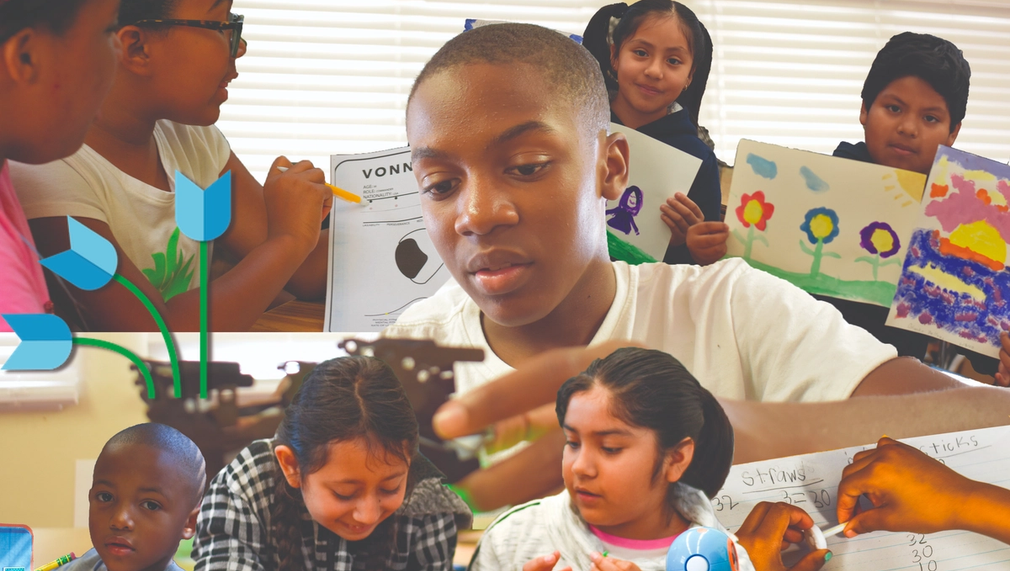Revolutionize STEAM for Black and Latinx youth
STEM to the Future (STTF) is altering the way we address the STEM pipeline gap for Black and Latinx students through a scalable social justice and STEAM-based curriculum. We are expanding our STEAM Residency program, which pairs Black and Latinx elementary and middle school aged youth with STEAM practitioners and activists. Our STEAM residents will lead students through project-based learning experiences that are aligned with their profession and help meet an unmet need in the community.

Please list the organizations collaborating on this proposal.
City Year Los Angeles
What is the primary issue area that your application will impact?
Access to Creative Industry Employment (sponsored by Snap Foundation)
In which areas of Los Angeles will you be directly working?
Central LA
South LA
In what stage of innovation is this project, program, or initiative?
Expand existing project, program, or initiative
What is your understanding of the issue that you are seeking to address?
Black and Latinx students have difficulty seeing themselves in traditional STEM careers, which are linked to higher earning potential and quality of life. The reasons are complex and unaddressed by current education and nonprofit programming. According to the Journal of Research in Science Teaching, Black and Latinx students are significantly more likely than their white peers to identify social change as essential to their career goals. Black and Latinx students’ disproportionate interest in social justice is causally linked to their underrepresentation in STEM. Additionally, the myth that STEM is for older students, which has been debunked by research supported by the National Science Foundation, has contributed to funding being concentrated in higher grade levels, depriving students of a critical foundation for future learning. Filtering Black and Latinx students out of STEM can impact the trajectory of their life and perpetuate social injustices in need of technical solutions.
Describe the project, program, or initiative this grant will support to address the issue.
STTF addresses this dire STEM career pipeline gap by delivering social justice and STEAM-based learning experiences in structured after-school and summer school settings within the community that invites parent and/or caregiver engagement. Our Theory and Practice (TxP) programs are student-led initiatives in which youth combine justice, STEAM, and activism as they work together to reimagine and create the communities they want and deserve. They are guided through the process of (1) creating a clear vision for the world they want and deserve, (2) using STEAM to develop projects that support their vision, and (3) connecting with the community and grassroots organizations to build and implement their projects. For this request, we are expanding our STEAM Residency program, which pairs TxP youth with STEAM practitioners and activists. Our STEAM residents will lead students through project-based learning experiences that are aligned with their profession and help meet an unmet need in the community. We are prioritizing practitioners and creatives who are Black, Latinx, and live or work in the same communities as our students. We’ve piloted this approach through our TxP initiative, Build’ Em Up Robotics, where Black and Latina girls were taught coding and robotics by two women of color both of which were engineers. These young leaders identified a gap in accessible PPE, which they addressed by building and programming robots to deliver PPE to vulnerable community members.
Describe how Los Angeles County will be different if your work is successful.
Our vision for success for the TxP STEAM Residency is to provide robust, experiential learning opportunities for more Black and Latinx youth in LA and thereby provide our students with the opportunity to lead and address an unmet need in our shared community. Additionally, we will begin analyzing our outcomes data so that we can refine our curriculum so that we can scale through sharing resources and teacher development and ultimately serve more youth. If our work is successful, Black and Brown youth in Los Angeles will be creating the pathways to liberating their communities. We envision more educators holding spaces like ours where students can dream up the world they want and deserve. More youth deserve the opportunity to live in those spaces and to be exposed to community organizing at a young age, in their own communities. They will have discovered the strength of the community and that they have the power and ability to create the world they want and deserve.
What evidence do you have that this project, program, or initiative is or will be successful, and how will you define and measure success?
STTF defines success through evidenced-based student learning and engagement outcomes, including: -100% of students were able to identify at least 3 contradictions in their community. -100% of students were able to use STEAM to meet at least one unmet need in their community -100% of students enjoyed classes that were taught by STEAM Residents from our community partner, Sustainable Economic Enterprises of Los Angeles (SEE_LA) -100% of students who attended our community partner events, including a mutual aid event with Japanese Town Action and Solidarity and our pop-up store with All Power Books, said that they wanted to do more of these events. Given these successful outcomes, especially the success we have had with every child identifying unmet needs in their community and working with peers to create something that addresses that unmet need, is evidence that our approach is working. Additionally, 80% of caregivers want classes to be increase from once a week to twice a week.
Approximately how many people will be impacted by this project, program, or initiative?
Direct Impact: 35
Indirect Impact: 300
Describe the specific role of the partner organization(s) in the project, program, or initiative.
In August 2023, January 2024, and March 2024, we will provide professiol development training to up to 45 City Year Los Angeles education partners working in LA elementary and middles schools so that they can recreate our residency model and/or resident-created curriculum in their home schools. This training will allow us to indirectly serve up to 300 additiol youth.